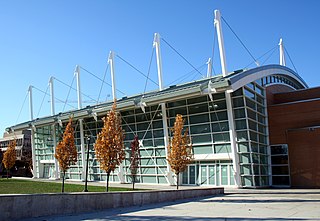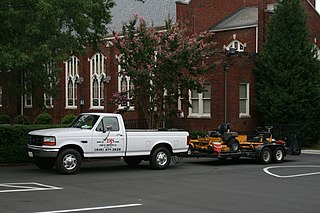
An architect is a person who plans, designs and oversees the construction of buildings. To practice architecture means to provide services in connection with the design of buildings and the space within the site surrounding the buildings that have human occupancy or use as their principal purpose. Etymologically, the term architect derives from the Latin architectus, which derives from the Greek, i.e., chief builder.

A garden is a planned space, usually outdoors, set aside for the cultivation, display, and enjoyment of plants and other forms of nature. The single feature identifying even the wildest wild garden is control. The garden can incorporate both natural and artificial materials.

Landscape architecture is the design of outdoor areas, landmarks, and structures to achieve environmental, social-behavioural, or aesthetic outcomes. It involves the systematic design and general engineering of various structures for construction and human use, investigation of existing social, ecological, and soil conditions and processes in the landscape, and the design of other interventions that will produce desired outcomes.

A landscape architect is a person who is educated in the field of landscape architecture. The practice of landscape architecture includes: site analysis, site inventory, site planning, land planning, planting design, grading, storm water management, sustainable design, construction specification, and ensuring that all plans meet the current building codes and local and federal ordinances.

Landscaping refers to any activity that modifies the visible features of an area of land, including the following:
- Living elements, such as flora or fauna; or what is commonly called gardening, the art and craft of growing plants with a goal of creating a beauty within the landscape.
- Natural abiotic elements, such as landforms, terrain shape and elevation, or bodies of water.
- Abstract elements, such as the weather and lighting conditions.
Building design refers to the broadly based architectural, engineering and technical applications to the design of buildings. All building projects require the services of a building designer, typically a licensed architect. Smaller, less complicated projects often do not require a licensed professional, and the design of such projects is often undertaken by building designers, draftspersons, interior designers, or contractors. Larger, more complex building projects require the services of many professionals trained in specialist disciplines, usually coordinated by an architect.
Garden design is the art and process of designing and creating plans for layout and planting of gardens and landscapes. Garden design may be done by the garden owner themselves, or by professionals of varying levels of experience and expertise. Most professional garden designers have some training in horticulture and the principles of design. Some are also landscape architects, a more formal level of training that usually requires an advanced degree and often a state license. Amateur gardeners may also attain a high level of experience from extensive hours working in their own gardens, through casual study, serious study in Master gardener programs, or by joining gardening clubs.
A general contractor, main contractor or prime contractor is responsible for the day-to-day oversight of a construction site, management of vendors and trades, and the communication of information to all involved parties throughout the course of a building project.
A garden designer is someone who designs the plan and features of gardens, either as an amateur or professional. The compositional elements of garden design and landscape design are: terrain, water, planting, constructed elements and buildings, paving, site characteristics and genius loci, and the local climatic qualities.

The Landscape Institute (LI) is a UK based professional body for the landscape profession. Its membership includes landscape architects, urban designers, landscape planners, landscape scientists and landscape managers. The LI also has a category for academic members.

Warren Henry Manning was an American landscape designer and promoter of the informal and naturalistic "wild garden" approach to garden design. In his designs, Manning emphasized pre-existing flora through a process of selective pruning to create a "spatial structure and character." An advocate for the conservation of the American landscape, Manning was a key figure in the formation of the American Society of Landscape Architects and a proponent of the National Park System.

The discussion of the history of landscape architecture is a complex endeavor as it shares much of its history with that of landscape gardening and architecture, spanning the entirety of man's existence. However, it was not until relatively recent history that the term "landscape architecture" or even "landscape architect" came into common use.

Architectural engineering, also known as building engineering or architecture engineering, is an engineering discipline that deals with the engineering systems - electrical, fire alarm, structural, mechanical and technological aspects of buildings.

Sustainable gardening includes the more specific sustainable landscapes, sustainable landscape design, sustainable landscaping, sustainable landscape architecture, resulting in sustainable sites. It comprises a disparate group of horticultural interests that can share the aims and objectives associated with the international post-1980s sustainable development and sustainability programs developed to address that humans are now using natural biophysical resources faster than they can be replenished by nature.

A gardener is someone who practices gardening, either professionally or as a hobby.

Landscape contracting is: "a profession that involves the art and technology of landscape and garden project planning, construction and landscape management, and maintenance and gardening; for garden aesthetics, human enjoyment and safety, and ecosystem-plant community sustainability."

Geraldine "Gerry" Knight Scott was a California landscape architect. She taught landscape architecture at the University of California, Berkeley and was a Fellow of the American Society of Landscape Architects. She was a founding member of the California Horticultural Society and received various awards and honors.

Marian Cruger Coffin was an American landscape architect who became famous for designing numerous gardens for members of the East Coast elite. As a child, she received almost no formal education but was home-tutored while living with her maternal relatives in upstate New York. Coffin was determined to embark on a career despite the social problems that it would cause for a woman of her class and enrolled at the Massachusetts Institute of Technology, where she studied between 1901–4 as one of only four women in architecture and landscape design.
John Andrew Brookes, MBE was a garden and landscape designer. He started designing gardens and landscapes in the late 1950s and designed thousands of gardens. He also taught and lectured about horticulture, landscape and interior design.
Edith Eleanor Schryver (1901–1984) was a founding partner of Lord & Schryver, the first female owned and operated landscape architecture firm in the Pacific Northwest from 1929 to 1969.
















